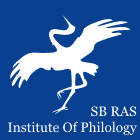 |
|
||||||||||||
|
Institute of Philology of
the Siberian Branch of Russian Academy of Sciences |
|
||||||||||||
|
|||||||||||||
|
DOI: 10.25205/2312-6337 Roskomnadzor certificate number Эл № ФС 77-84783
| |
| Yazyki i Fol’klor Korennykh Narodov Sibiri (Languages and Folklore of Indigenous Peoples of Siberia) | |
|
ArticleName: Knives of Yukaghir fairy tale characters: ethnographic realities and folklore context Authors: P. E. Prokopeva The Institute for Humanities Research and Indigenous Studies of the North of the SB RAS, Yakutsk, Russian Federation In the section Фольклор: этнографический аспект
Abstract: This paper focuses on the contemporary issue of the objective world in fairy-tale prose. Analysis of its ethnographic basis may facilitate a deeper understanding of the substantive and artistic features of the folklore text, including its symbolic context. An ethnographic and semantic analysis of Forest Yukaghir fairy tales is presented, with particular attention paid to the portrayal of knives. The corpus of this research comprised the fairy tales of the Forest Yukaghirs, assembled from the late 19th to the early 20th centuries. Examination of ethnographic and folklore sources related to the Forest Yukaghirs reveals the multifaceted nature and diverse applications of their knives. Ethnographic realities are prominently featured in the remarkable Yukaghir folklore, particularly in descriptions of knives with diverse materials and uses. Featured in the texts are knives of bone, wood, and iron. The practical application of knives by fairytale characters mirrors that of humans, encompassing fishing, preparing food, crafting, and sewing. Alternatively, within folklore imagery, knives can symbolize character size, gender, or a trickster’s personality. In fairy-tales, a knife can take on an unreal appearance, corresponding to the image of its owner and the logic of the plot. Plots sometimes feature semantically significant segments that involve a knife. The multifaceted nature of knives provides a basis for figurative comparisons. Keywords: Yukaghir folklore, Yukaghir ethnography, Forest Yukaghirs, knife, tale Bibliography: Berezkin Yu. E., Duvakin E. N. Tematicheskaya klassifikatsiya i raspredelenie fol’klorno-mifologicheskikh motivov po arealam: Analiticheskiy katalog [Thematic classification and distribution of folklore and mythological motifs by areas: Analytical catalog]. URL: http://www.ruthenia.ru/folklore/berezkin (accessed: 15.06.2024). (In Russ.) Fol’klor yukagirov [The folklore of the Yukaghirs]. G. N. Kurilov (Comp.). Moscow, Novosibirsk, Nauka, 2005, 594 p. (Pamyatniki fol’klora narodov Sibiri i Dal’nego Vostoka [Monuments of folklore of the peoples of Siberia and the Far East]; Vol. 25). (In Russ. and Yukagh.) Fol’klor yukagirov Verkhney Kolymy [The folklore of the Upper Kolyma Yukaghirs]. L. N. Zhukova, I. A. Nikolaeva, L. N. Demina (Comps.). Yakutsk, YSU Publ., 1989, pt. 1, 161 p.; 1989, pt. 2, 89 p. (In Russ. and Yukagh.) Golovaneva T. A. Nozh kak kriteriy sily i nezavisimosti v fol’klore osedlykh koryakov [The knife as a criterion of strength and independence in the folklore of the settled Koryaks]. Yazyki i Fol’klor Korennykh Narodov Sibiri [Languages and Folklore of Indigenous Peoples of Siberia]. 2016, no. 2 (iss. 31), pp. 57–62. (In Russ.) Iokhel’son V. I. Materialy po izucheniyu yukagirskogo yazyka i fol’klora, sobrannye v Kolymskom okruge [The materials for Yukaghir language and folklore study collected in the Kolymsky district]. Yakutsk, Bichik, 2005a, 272 p. (In Russ.) Iokhel’son V. I. Yukagiry i yukagirizirovannye tungusy [The Yukaghir and the Yukaghirized Tungus]. Novosibirsk, Nauka, 2005b, 675 p. (In Russ.) Nikolaeva I. A., Shalugin V. G. Slovar’ yukagirsko-russkiy i russko-yukagirskiy (Verkhnekolymskiy dialekt): Ucheb. posobie dlya uch-sya nach. shk. [Dictionary of Yukaghir-Russian and Russian-Yukaghir (Verkhnekolymsky dialect): Textbook for elementary schools]. St. Pe-tersburg, 2002, 224 p. (In Russ.) Prokopeva P. E. Yukagirskaya skazka o malen’kom okhotnike na losya: semantika obraza (v sopostavlenii s yakutskoy skazkoy) [The Yukaghir tale of the little moose hunter: Semantics of the image (in comparison with the Yakut fairy tale)]. Philological Sciences. Issues of Theory and Practice. 2024, vol. 17, iss. 6, pp. 1803–1808. (In Russ.) Prokopeva P. E. Ustnaya neskazochnaya traditsiya yukagirov [The oral untold tradition of the Yukaghirs]. Novosibirsk, Nauka, SB RAS Publ. House, 2018, 308 p. Prokopeva P. E., Prokop’eva A. E. Yukagirsko-russkiy slovar (yazyk lesnykh yukagirov) [Yukaghir-Russian dictionary (Language of the Forest Yukaghirs)]. Novosibirsk, Nauka, 2021, 412 p. (In Russ., Yukagh.) Spiridonov N. I. Yukagirsko-russkiy slovar’. Evensko-russkiy slovar’ [Yukaghir-Russian dictionary. Even-Russian dictionary]. Yakutsk, YSU Publ., 2003, 57 p. (In Russ. and Yukagh.) Zhukova L. N. Fol’klor i etnografiya o vooruzhenii lesnykh yukagirov (konets 19 – konets 20 vv.) [Folklore and ethnography about the armament of Forest Yukaghirs (late 19th – late 20th centuries)]. In: Fol’klor paleoaziatskikh narodov: IV Mezhdunarodnaya nauchno-prakticheskaya konferentsiya (8–11 noyabrya 2022 g.): sb. materialov [Folklore of the Paleoasiatic peoples: IV International Scientific and Practical Conference (November 8–11, 2022): coll. of materials]. Yuzhno-Sakhalinsk, Ostrovnaya biblioteka, 2023, рр. 41–49. (In Russ.) Zhukova L. N. Traditsionnye formy nozhey aborigennogo naseleniya Kolymy i Chukotki: ot kamennoy industrii k izdeliyam iz zheleza [Traditional knife shapes of the indigenous population of Kolyma and Chukotka: from the stone industry to iron products]. Humanities Research in the Russian Far East. 2017, no. 4, pp. 22–28. (In Russ.) |
 |
ИФЛ СО РАН 630090, Новосибирск, ул. Николаева, 8 тел./факс: 8-(383)330-15-18, ifl@philology.nsc.ru |
Карта сайта Дизайн © ИФЛ СО РАН |


